Stefanie Schneider Color Photography
Early 2000s Contemporary Stefanie Schneider Color Photography
Archival Paper, C Print, Color, Polaroid
Early 2000s Contemporary Stefanie Schneider Color Photography
Archival Paper, C Print, Color, Polaroid, Photographic Paper
Early 2000s Contemporary Stefanie Schneider Color Photography
Archival Paper, Photographic Paper, C Print, Color, Polaroid
Early 2000s Contemporary Stefanie Schneider Color Photography
Archival Paper, Photographic Paper, C Print, Color, Polaroid
Early 2000s Contemporary Stefanie Schneider Color Photography
Archival Paper, Photographic Paper, C Print, Color, Polaroid
Early 2000s Contemporary Stefanie Schneider Color Photography
Archival Paper, Photographic Paper, C Print, Color, Polaroid
Early 2000s Contemporary Stefanie Schneider Color Photography
Archival Paper, Photographic Paper, C Print, Color, Polaroid
Early 2000s Contemporary Stefanie Schneider Color Photography
Archival Paper, Photographic Paper, C Print, Color, Polaroid
Early 2000s Contemporary Stefanie Schneider Color Photography
Archival Paper, Photographic Paper, C Print, Color, Polaroid
Early 2000s Contemporary Stefanie Schneider Color Photography
Archival Paper, Photographic Paper, C Print, Color, Polaroid
2010s Contemporary Stefanie Schneider Color Photography
Archival Paper, Photographic Paper, C Print, Color, Polaroid
Early 2000s Contemporary Stefanie Schneider Color Photography
Archival Paper, Photographic Paper, C Print, Color, Polaroid
Early 2000s Contemporary Stefanie Schneider Color Photography
Archival Paper, Photographic Paper, C Print, Color, Polaroid
Early 2000s Contemporary Stefanie Schneider Color Photography
Archival Paper, Photographic Paper, C Print, Color, Polaroid
Early 2000s Contemporary Stefanie Schneider Color Photography
Archival Paper, Photographic Paper, C Print, Color, Polaroid
Early 2000s Contemporary Stefanie Schneider Color Photography
Archival Paper, Photographic Paper, C Print, Color, Polaroid
Early 2000s Contemporary Stefanie Schneider Color Photography
Archival Paper, Photographic Paper, C Print, Color, Polaroid
Early 2000s Contemporary Stefanie Schneider Color Photography
Archival Paper, Photographic Paper, C Print, Color, Polaroid
Early 2000s Contemporary Stefanie Schneider Color Photography
Plexiglass, Archival Paper, Color, Lambda, Polaroid
Early 2000s Contemporary Stefanie Schneider Color Photography
Archival Paper, C Print, Color, Lambda, Polaroid
Early 2000s Contemporary Stefanie Schneider Color Photography
Archival Paper, Photographic Paper, C Print, Color, Polaroid
Early 2000s Contemporary Stefanie Schneider Color Photography
Archival Paper, Photographic Paper, C Print, Color, Polaroid
Early 2000s Contemporary Stefanie Schneider Color Photography
Archival Paper, Photographic Paper, C Print, Color, Polaroid
Early 2000s Contemporary Stefanie Schneider Color Photography
Archival Paper, Photographic Paper, C Print, Color, Polaroid
Early 2000s Contemporary Stefanie Schneider Color Photography
Archival Paper, Photographic Paper, C Print, Color, Polaroid
Early 2000s Contemporary Stefanie Schneider Color Photography
Archival Paper, Photographic Paper, C Print, Color, Polaroid
Early 2000s Contemporary Stefanie Schneider Color Photography
Archival Paper, Photographic Paper, C Print, Color, Polaroid
Early 2000s Contemporary Stefanie Schneider Color Photography
Archival Paper, Photographic Paper, C Print, Color, Polaroid
Early 2000s Contemporary Stefanie Schneider Color Photography
Archival Paper, Photographic Paper, C Print, Color, Polaroid
Early 2000s Contemporary Stefanie Schneider Color Photography
Archival Paper, Photographic Paper, C Print, Color, Polaroid
Early 2000s Contemporary Stefanie Schneider Color Photography
Archival Paper, Photographic Paper, C Print, Color, Polaroid
Early 2000s Contemporary Stefanie Schneider Color Photography
Archival Paper, Photographic Paper, C Print, Color, Polaroid
Early 2000s Contemporary Stefanie Schneider Color Photography
Archival Paper, Photographic Paper, C Print, Color, Polaroid
1990s Contemporary Stefanie Schneider Color Photography
Archival Paper, Photographic Paper, C Print, Color, Polaroid
1990s Contemporary Stefanie Schneider Color Photography
Archival Paper, Photographic Paper, C Print, Color, Polaroid
1990s Contemporary Stefanie Schneider Color Photography
Archival Paper, Photographic Paper, C Print, Color, Polaroid
1990s Contemporary Stefanie Schneider Color Photography
Archival Paper, Photographic Paper, C Print, Color, Polaroid
1990s Contemporary Stefanie Schneider Color Photography
Archival Paper, Photographic Paper, C Print, Color, Polaroid
Early 2000s Contemporary Stefanie Schneider Color Photography
Archival Paper, Photographic Paper, C Print, Color, Polaroid
1990s Contemporary Stefanie Schneider Color Photography
Archival Paper, Photographic Paper, C Print, Color, Polaroid
1990s Contemporary Stefanie Schneider Color Photography
Archival Paper, Photographic Paper, C Print, Color, Polaroid
1990s Contemporary Stefanie Schneider Color Photography
Archival Paper, Photographic Paper, C Print, Color, Polaroid
1990s Contemporary Stefanie Schneider Color Photography
Archival Paper, Photographic Paper, C Print, Color, Polaroid
1990s Contemporary Stefanie Schneider Color Photography
Archival Paper, Photographic Paper, C Print, Color, Polaroid
1990s Contemporary Stefanie Schneider Color Photography
Archival Paper, Photographic Paper, C Print, Color, Polaroid
1990s Contemporary Stefanie Schneider Color Photography
Archival Paper, Photographic Paper, C Print, Color, Polaroid
1990s Contemporary Stefanie Schneider Color Photography
Archival Paper, Photographic Paper, C Print, Color, Polaroid
2010s Contemporary Stefanie Schneider Color Photography
Archival Paper, Photographic Paper, C Print, Color, Polaroid
2010s Contemporary Stefanie Schneider Color Photography
Archival Paper, Photographic Paper, C Print, Color, Polaroid
Early 2000s Contemporary Stefanie Schneider Color Photography
Archival Paper, Photographic Paper, C Print, Color, Polaroid
Early 2000s Contemporary Stefanie Schneider Color Photography
Archival Paper, Photographic Paper, C Print, Color, Polaroid
Early 2000s Contemporary Stefanie Schneider Color Photography
Archival Paper, Photographic Paper, C Print, Color, Polaroid
1990s Contemporary Stefanie Schneider Color Photography
Archival Paper, Photographic Paper, C Print, Color, Polaroid
1990s Contemporary Stefanie Schneider Color Photography
Archival Paper, Photographic Paper, C Print, Color, Polaroid
1990s Contemporary Stefanie Schneider Color Photography
Archival Paper, Photographic Paper, C Print, Color, Polaroid
2010s Contemporary Stefanie Schneider Color Photography
Archival Paper, Photographic Paper, C Print, Color, Polaroid
2010s Contemporary Stefanie Schneider Color Photography
Archival Paper, Photographic Paper, C Print, Color, Polaroid
2010s Contemporary Stefanie Schneider Color Photography
Archival Paper, Photographic Paper, C Print, Color, Polaroid





